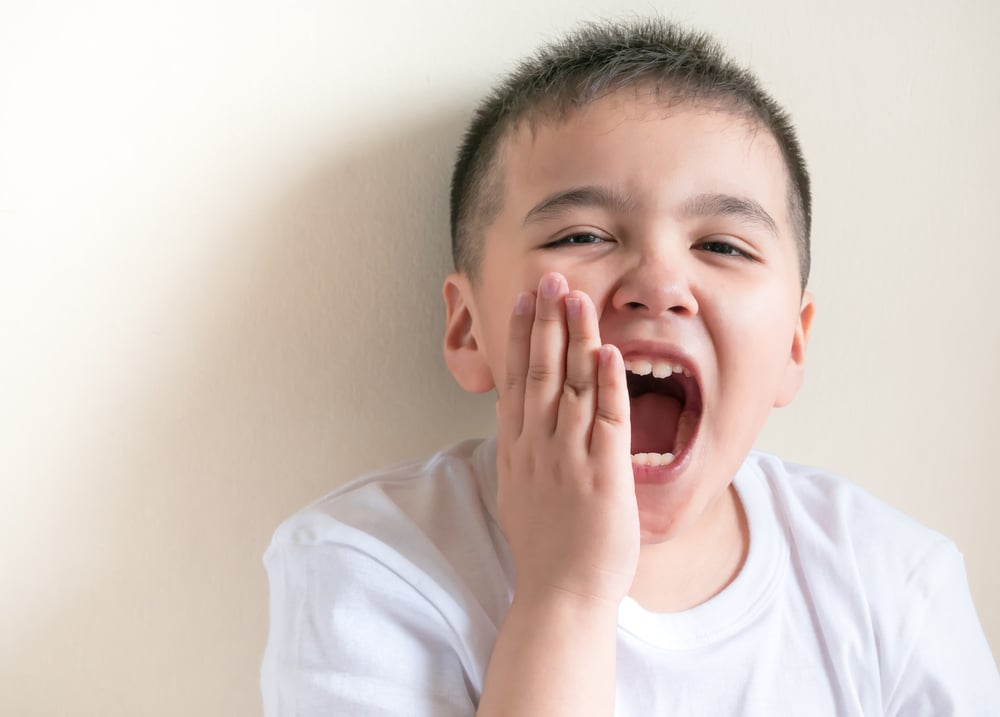Has your child been showing signs of jaw pain? Perhaps you’ve seen them rubbing their jaw, maybe they’re less excited about eating, or maybe they’ve told you it hurts.
Jaw pain is surprisingly common amongst both kids and adults. While there are several causes of jaw pain, one of the more common explanations we find with kids is that they have a misaligned bite (also known as malocclusion).
The good news is — misaligned bites can be fixed! In this article, we’ll explain how misaligned bites can cause problems, and how you can help solve the problem of your child’s jaw pain.
How a misaligned bite causes jaw pain
Eating delicious food is an American pastime, and kids certainly love participating. As you know, when we eat we use our jaw muscles. What you may not know, however, is that your jaw is an extremely strong muscle, and chewing can generate forces as high as several hundred pounds of force per square inch.
If you or your child has a misaligned bite, those powerful jaw muscles will not bite down evenly. This can create imbalance or place significant pressure on specific teeth. Your jaw muscles will attempt to correct this, but often overcompensate. As you can imagine, chewing in this manner over time can lead to soreness in your jaw.
When jaw pain becomes severe it can affect more than just your child’s eating. It can also interfere with breathing, sleeping, speech, and even cause discomfort when the jaw isn’t moving. The joint where the upper and lower jaw meet is complex, and so if it cannot function properly, it can lead to chronic pain.
Imagine if you wore two different types of shoes and one was an inch taller. It might not be painful at first, but by the end of the day you’d likely feel sore in both your legs and back because your balance has been misaligned. It’s the same with a bad bite, except we can’t fix it by simply taking off our shoe! We must deal with it every day or we must find a way to correct the bite.
What causes a misaligned bite?
There are several reasons your child might have a misaligned bite:
-
Most commonly, a bad bite or crooked teeth is simply the result of genetics.
-
Their mouths are too small for their teeth, causing them to get overcrowded and shift.
-
Their upper jaw and lower jaws are not the same size.
-
Early loss of baby teeth.
-
They experienced a jaw injury.
-
Thumb sucking, tongue thrusting, pacifier use beyond the age of three, or prolonged use of a bottle.
As you can see, in most cases there is nothing you can do to prevent a misaligned bite from happening, but there are steps you can take to correct it.
Treatments for misaligned bites
Since every bite is different, there is no one-size-fits-all treatment. The following are some of the most common ways your orthodontist will help correct your child’s bite.
Braces: Braces are the most common way to correct a misaligned bite. With this treatment, we place metal brackets to the front of the teeth and connect them with a wire. The wire is regularly tightened to slowly move the location of the teeth and jaw. Rubber bands might also be used to apply pressure that can slowly put the mouth into better alignment. After treatment is complete with braces, we will provide a retainer that helps keep your child’s teeth in the correct location.
Upper Jaw Expander: An upper jaw expander is an appliance that helps correct an underbite. The appliance is a wire frame device that fits across the upper palate, and you use a special key to widen the expander a tiny amount every night. This slowly causes the upper jaw to get wider, thus fixing the misaligned bite.
Jaw Surgery: Although rare, some people do require jaw surgery to correct their bite. Surgery is typically only for patients who experience misalignment that affects everyday functions such as eating, speaking and sleeping. Fortunately, with children, we can usually correct the alignment issue before it gets so bad that surgery is required.
There are other ways of treating misalignment, and your child might require a combination of appliances and braces. Whatever the case, you can trust that at Palm Tree Orthodontics, we will speak honestly and work to find the best treatment possible for your child.
Benefits of fixing a misaligned bite
As we’ve said already, fixing a misaligned bite can prevent jaw pain. This alone is a great incentive to make a change, but there are other benefits you and your child should know about, as well:
-
Teeth are easier to clean, which reduces the risk of tooth decay and cavities later in life.
-
The confidence that comes from having a brilliant-looking smile will increase.
-
They will speak with more clarity.
-
They’re less likely to chip or lose teeth.
Correcting your child’s misaligned bite is an important investment, but it is also one that will reap rewards for years to come.
If you’re in the Lakeland area, then contact us at Palm Tree Orthodontics to discuss your options. Our priority is to make a positive impact in your child’s life by enhancing self confidence, self esteem, and overall dental health. Correcting their misaligned bite is one of the best ways we can do all three!
Posted by Palm Tree Orthodontics

